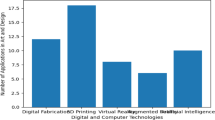
Overview
- Illustrates the widening intersection and importance of technology and the arts
- Explains how interdisciplinary challenges can be addressed effectively
- Generates new creative ideas through technology’s interaction with the arts
- Shares many insights of artists and technologists on the creative process
- Enables current and future opportunities in technology and the arts to be realized
Part of the book series: Springer Series on Cultural Computing (SSCC)
Buy print copy
Tax calculation will be finalised at checkout
About this book
This open access book details the relationship between the artist and their created works, using tools such as information technology, computer environments, and interactive devices, for a range of information sources and application domains. This has produced new kinds of created works which can be viewed, explored, and interacted with, either as an installation or via a virtual environment such as the Internet. These processes generate new dimensions of understanding and experience for both the artist and the public’s relationships with the works that are produced. This has raised a variety of interdisciplinary opportunities and issues, and these are examined.
The symbiotic relationship between artistic works and the cultural context in which they are produced is reviewed. Technology can provide continuity by making traditional methods and techniques more efficient and effective. It can also provide discontinuity by opening up new perspectives and paradigms. This can generate new ideas, and produce a greater understanding of artistic processes and how they are implemented in practice.Tools have been used from the earliest times to create and modify artistic works. For example, naturally occurring pigments have been used for cave paintings. What has been created provides insight into the cultural context and social environment at the time of creation. There is an interplay between the goal of the creator, the selection and use of appropriate tools, and the materials and representations chosen.
Technology, Design and the Arts - Opportunities and Challenges is relevant for artists and technologists and those engaged in interdisciplinary research and development at the boundaries between these disciplines.
Similar content being viewed by others
Keywords
Table of contents (20 chapters)
-
Front Matter
-
A Panoramic View of the Field
-
Front Matter
-
-
Facilitating Communication Between the Arts, Technology, and Audiences
-
Front Matter
-
-
Interactions Between the Arts and Data
-
Front Matter
-
-
Audio Visual Installations to Generate Collective Human Responses
-
Front Matter
-
-
The Convergence of Digital Design, the Arts, Computing, and the Environment
-
Front Matter
-
Editors and Affiliations
Bibliographic Information
Book Title: Technology, Design and the Arts - Opportunities and Challenges
Editors: Rae Earnshaw, Susan Liggett, Peter Excell, Daniel Thalmann
Series Title: Springer Series on Cultural Computing
DOI: https://doi.org/10.1007/978-3-030-42097-0
Publisher: Springer Cham
eBook Packages: Computer Science, Computer Science (R0)
Copyright Information: The Editor(s) (if applicable) and The Author(s) 2020
Hardcover ISBN: 978-3-030-42096-3Published: 23 June 2020
Softcover ISBN: 978-3-030-42099-4Published: 18 September 2020
eBook ISBN: 978-3-030-42097-0Published: 22 June 2020
Series ISSN: 2195-9056
Series E-ISSN: 2195-9064
Edition Number: 1
Number of Pages: XXV, 387
Number of Illustrations: 14 b/w illustrations, 148 illustrations in colour
Topics: User Interfaces and Human Computer Interaction, Computer Appl. in Arts and Humanities, Media Design, Information Systems Applications (incl. Internet)



